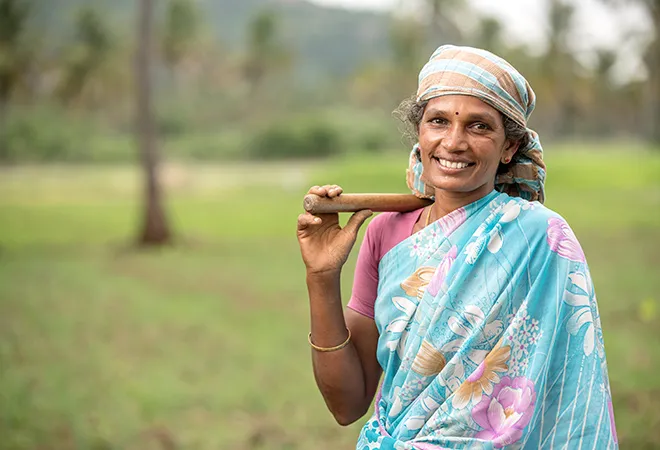
The Sustainable Development Goals (SDGs) are an ambitious declaration of global aspirations, ranging from eliminating poverty, hunger, and violence against women to providing legal identity and equal access to justice to every person in the world. Adopted unanimously by the 193 UN Member States in September 2015, the SDGs are meant to guide global development efforts for 15 years, from 2015 to 2030.
India was an influential player in the international negotiations that produced the SDGs, voicing critical developing country concerns and pressing developed countries to clarify their obligations. India’s interventions shaped many aspects of the SDGs, including the geographical scope of the goals. The SDGs are meant to apply to every country of the world whereas its predecessors, the Millennium Development Goals, targeted developing countries alone. This is a radical shift that transforms the concept of ‘development’ — especially ‘sustainable development’ — into one that is pertinent not only to the global South, but to all countries, rich and poor.
Despite its many revolutionary features, however, the SDGs suffer from a fundamental weakness. They constitute a voluntary agreement rather than a binding treaty, which means that compliance will always be a problem. Unless individual states, especially the more powerful ones, move decisively towards achieving the goals, the SDGs will remain an utopian dream and symbol of failing global cooperation.
Despite its many revolutionary features, however, the SDGs suffer from a fundamental weakness. They constitute a voluntary agreement rather than a binding treaty, which means that compliance will always be a problem.
Given its rising world power status and prominent role in the formulation of the SDGs, India arguably has a special duty to bring these goals to fruition. To this end, it is encouraging that Prime Minister Modi has affirmed India’s strong commitment to the SDGs in multiple global forums, and that the NITI Aayog has recently published the SDG India Index: Baseline Report 2018, which tracks the progress of all the Indian States and Union Territories (UTs) towards meeting the SDGs. This landmark report merits close analysis since it is the Indian government’s first major step towards translating its principled commitment to the SDGs into actionable policy. It is to such analysis that we now turn.
One key strength of the Index is that it is transparent and accessible to the non-specialist. It is delivered in plain language and colourful charts, and the methods used to track progress towards different goals and targets are spelled out clearly. Furthermore, a chart at the end of the report assigns responsibility for achieving the goals to specific ministries and departments. For example, the responsible parties for realising the health goal, SDG-3, include Health and Family Welfare, AYUSH, and even Home Affairs (for achieving the target on prevention and treatment of substance abuse). Naming specific ministries and departments is an important step towards improving accountability since it gives an indication of who exactly, institutionally speaking, should be blamed if a particular goal is missed. The exercise of assigning institutional responsibility to each SDG also renders clear that no goal can be achieved in the absence of coordination between multiple departments and ministries, and is therefore an important reminder to different arms of the government to work together rather than in silos.
One key strength of the Index is that it is transparent and accessible to the non-specialist.
The Index also provides a useful comparative account of how well different States and UTs have done so far in meeting the development objectives identified in the SDGs. With regard to eliminating hunger, for instance, we learn that Manipur and Kerala are doing much better than Gujarat and Jharkhand (see p. 31), and with regard to reducing gender inequality, Kerala and Sikkim are well ahead of Manipur and Bihar (p. 66). Such cross-state comparisons, which have caught the media’s interest, should also be of interest to academics and policymakers, pushing them to ask what top performers such as Kerala are doing right, and what States that are lagging behind are doing wrong.
The many strengths of the report do not, however, entirely make up for its weaknesses.
First, the Index contains a number of large gaps. Four key goals, including the one on combatting climate change and its impacts (SDG-13) are not covered by the Index. For almost every goal that is covered, furthermore, many associated targets are not. For example, the Index covers only two of the seven targets of the urban goal, SDG-11, on building inclusive, safe, and sustainable cities. This is cause for concern in a country that is rapidly urbanising, and where the urban population is expected to grow to 814 million by 2050. Also worrying is that the Index covers only one of the seven targets of the education goal, SDG-4, on ensuring equitable quality education for all. Among the targets that fall by the wayside is a crucial one on eliminating gender disparities in education, which is an issue that India can ill-afford to neglect.
Indeed, a major shortcoming of the report is that it does not sufficiently reflect the SDGs’ emphasis on eliminating disparities and empowering the poorest and hardest to reach. Widely endorsed in the global consultations leading up to the post-2015 agenda, the promise to ‘leave no one behind’ is a distinctive feature of the SDGs, and is reflected in many goals and targets, including SDG-17.18’s pledge to develop data disaggregated “by income, gender, age, race, ethnicity, migratory status, disability, geographic location and other characteristics relevant in national context.” The principle of leaving no one behind commits signatory states, like India, to consider targets achieved only if they are met for all segments of a population. The SDG India Index does not do enough, regrettably, to meet this important obligation. For example, while the report acknowledges that hunger poses a challenge in India because of a number of factors such as “structural inequalities (gender, caste, social groups),” the indicators selected for the ‘zero hunger’ goal (SDG-2) do not account for any such ‘structural inequalities’ (see p. 29).
A major shortcoming of the report is that it does not sufficiently reflect the SDGs’ emphasis on eliminating disparities and empowering the poorest and hardest to reach.
The hunger indicators are not the only ones that are weak. Many indicators named in the Index fail to capture the full intent of their associated targets, or for that matter, the larger ‘transformative’ aim of the SDGs. Take, for example, the indicator developed for measuring progress towards target 5.2 on eliminating ‘all forms of violence against all women and girls in the public and private spheres.’ The reach of the indicator — ‘percentage of ever married woman aged 15-49 years who have ever experienced spousal violence’ (p. 65) — is quite inadequate, and not least because intimate partner violence is grossly under-reported in India. Many such indicators will need to be reworked in the face of the commitment to ‘leave no one behind.’
Yet another problem is that the Index provides little information on how specific goals are to be achieved. For instance, while the report lists about a dozen central government schemes that are supposedly “aligned with the targets outlined under goal” (p. 35) — these include the Integrated Child Development Scheme (ICDS), which has been around since the 1970s, and POSHAN Abhiyaan, which was launched in 2017 — nothing is said about how exactly each of these schemes will contribute towards meeting the selected targets. This is an important question in a country where costly duplication among government schemes is a serious concern. Little is clearly said, moreover, about how the goals will ultimately be financed, especially at the state-level. This is indeed a grave concern given that (conservative) estimates suggest that India faces a financial shortfall of approximately INR 533 lakh crores, or USD 8.5 trillion, over the mandated 15 years for achieving the SDGs (see this report on financing the SDGs in India, p. 13).
The Index provides little information on how specific goals are to be achieved.
To be fair, many of the Index’s limitations are acknowledged at the outset. The omission of numerous goals and targets is attributed, for example, to the “unavailability of comparable data across States and UTs” (p. 4). In fact, one invaluable aspect of the report is that it brings into sharp focus the weakness of India’s data systems, in both a general sense and in relation to specific areas for which goals and targets are entirely missing (such as for combating climate change). The report makes it crystal clear that there is an urgent need for investment in the production of reliable, timely, consistent and, most crucially, comparable development data.
Overall, the SDG India Index produced by the NITI Aayog is a good start towards meeting India’s obligation to fulfill the SDGs. But future developments will need to be watched with a critical eye. The government has promised, in subsequent reports, to refine indicators, improve data collection and reporting processes, and explore the potential for disaggregating data (p.1). Progress in all of these areas will need to be monitored carefully, and special effort will have to be made to keep definitions and methods constant along the way. The government should receive unreserved applause only when it definitively moves from addressing the easier tasks set out in the agenda — your proverbial ‘low hanging fruit’ — to those that are more difficult, but ultimately more transformative.
The views expressed above belong to the author(s). ORF research and analyses now available on Telegram! Click here to access our curated content — blogs, longforms and interviews.




 PREV
PREV


